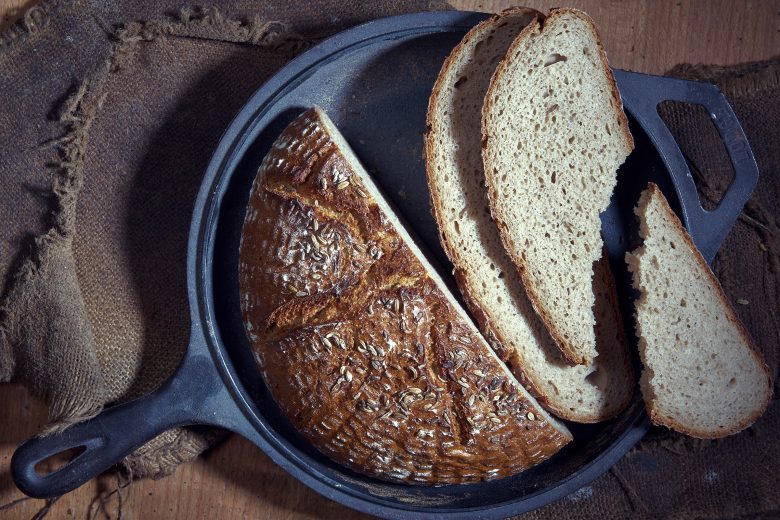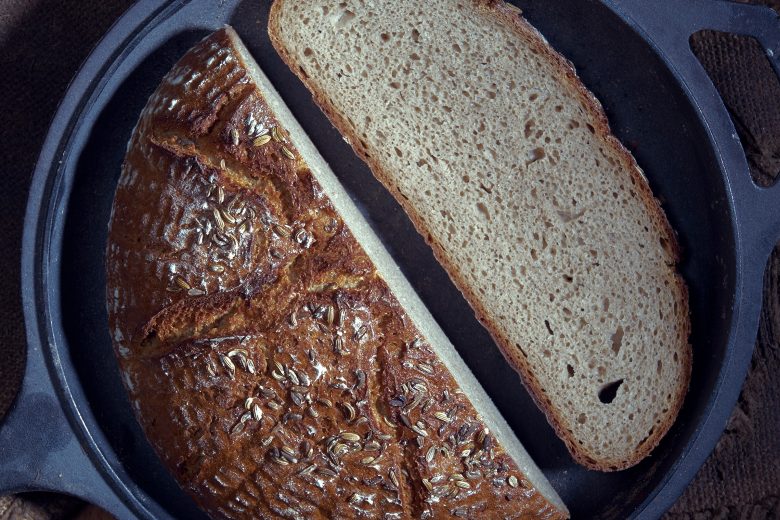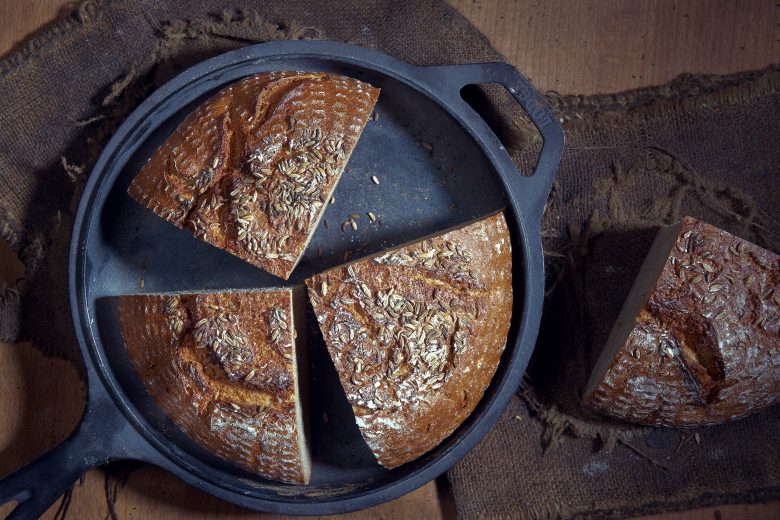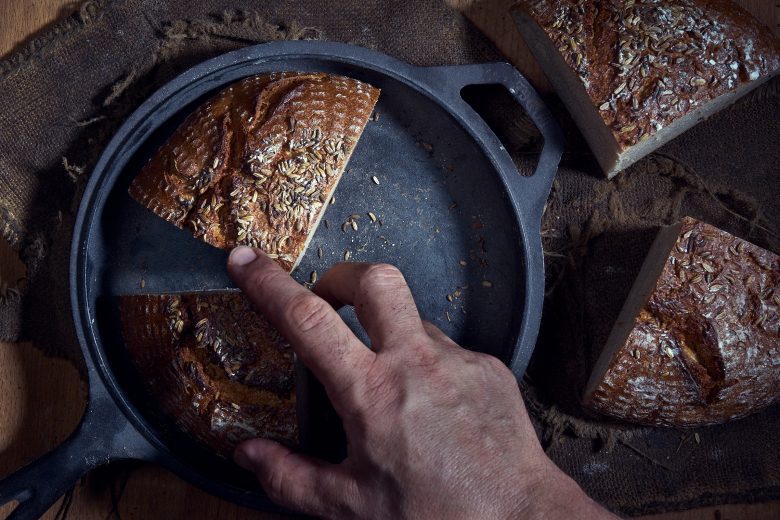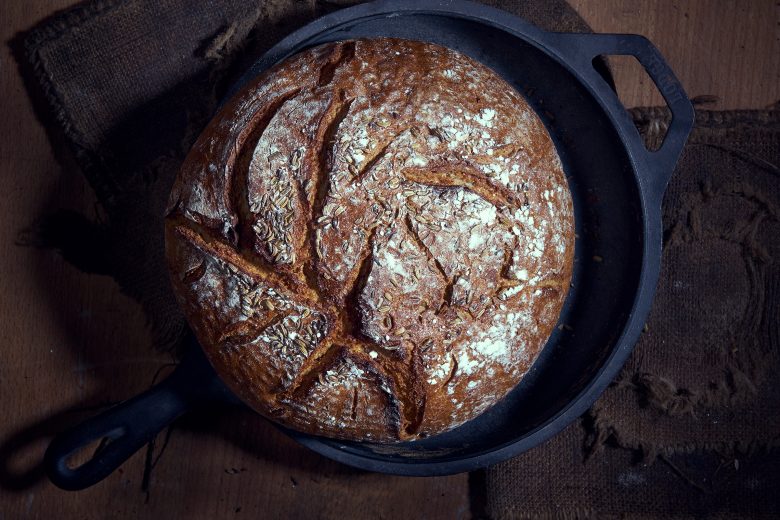Mixed Rye Bread
The new rye harvest of 2019 probably drew more notice from professional bakers than hobby bakers. Rye bread characteristics that stood out were:
- A lack of moisture and inadequate preservation of freshness
- Stale bread taste
- Overly tight crumb
- Poor dough development
- Dough that gets progressively harder
These problems usually gradually slip into the bakery, again and again (at least they do for me), and eventually mutate into a giant disaster. (Schelli likes to say: “My friend, you’ve been generously peed upon again!”) When it generously pees upon someone like me, this leads to sleepless nights–and to be honest, it was a few weeks.
When the falling number, Amylograph viscosity curve, and gelatinization temperature all continue to rise, it is no longer enough to experiment with the sourdough. In this case, various measures have to be taken in the creation of the sourdough, the dough working process and the baking phase.
Sourdough:
- Slightly Increase starter amount
- Lengthen the base souring stage for multistage sourdoughs
- When possible, use an higher-type flour or include a portion of whole grain in the mixture
- Slightly increase the sourdough used in the main recipe
The advantage of multistage sourdoughs is that you can more precisely control and steer the level of acidity. This allows you to add more acidity to a mild sourdough, which in turn leads to better preservation of freshness.
Dough creation:
- Increase hydration
- Use old bread or increase add-ins
- Add fat (lard, sunflower oil, etc….)
- A scald (water and near boiling water)
- Finely ground psyllium seed husk
- Increase maturation time for small amounts of dough by 5-10 minutes
- Keep dough temperature at 30-32°C
It’s up to you to choose whether to add ground psyllium seed husk, a scald, old bread or fat, but these measures help make the bread stay fresh longer.
Baking stage:
- Slightly lower baking temperature
- Increase baking time
Recipe
For a dough weight of 1908g
Total amount of sourdough 763g / TA 210
| 330g | Rye flour type 960 / 997 | 33% |
| 30g | Dark rye flour type 2500 or finely ground whole grain flour | 3% |
| 396g | Water | |
| 7g | Starter | 2% |
1. Stage – Refresh Sour
| 10g | Rye flour type 960 / 997 | 3% |
| 10g | Water | 2,5% |
| 7g | Starter | 2% |
Dissolve the start in the water and mix it with the rye flour until no lumps are left. Desired temperature 28-30°C / maturation time 3 hours.
2. Stage – Foundation Sour
| 27g | Mature refreshed sourdough | 100% |
| 100g | Rye flour type 960 / 997 | 28% |
| 30g | Rye flour type 2500 or whole grain flour | 8% |
| 90g | Water | 22% |
Dissolve the refreshed sour starter in the water and then mix it with the rye flour until no lumps are left. Desired dough temperature 24-25°C / maturation time 8-10 hours.
3. Stage – Full Sour
| 247g | Mature foundation sourdough | 100% |
| 220g | Rye flour type 960 / 997 | 61% |
| 296g | Water | 74,5% |
Dissolve the mature foundation sour starter in water and mix it with the rye flour until no lumps are left. Desired dough temperature 30-32 °C / maturation time 3 hours.
Bread soaker
| 40g | Soft old bread | 66,6% |
| 20g | Dried, roasted and finely ground old bread | 33,3% |
| 150g | Water 35°C | 100% |
Puree the soft old bread and the water with a hand mixer, eventually mixing in the dried old bread.
Main dough
| 763g | Mature full sourdough | 100% |
| 210g | Softened bread soaker | 100% |
| 440g | Rye flour type 960 / 997 | 44% |
| 200g | Wheat flour type 700 | 20% |
| 250g | Water 45°C | 100% |
| 22g | Salt | 2,2% |
| 20g | Lard / sunflower oil | 2% |
| 3g | Bread spice | 0,3% |
Instructions
- Add the sourdough, water, flour and remaining ingredients to the kneading bowl and mix it slowly for 6 minutes, finally kneading it quickly for 1 minute.
- Let the dough rest for 15-20 minutes.
- Divide the dough into two pieces of equal size and shape them into round loaves (see video https://www.homebaking.at/brotteig-1-rundwirken/).
- Place the shaped loaves seam-side down in a flour proofing basket in preparation for the final proof.
- Let it prove for c. 50-60 minutes (the times correspond to a dough temperature of 30-32°C)
- Bake the loaves seam-side up in an oven preheated to 250°C. Ensure there is plenty of steam as the bread starts to bake. Release the steam once the desired cracks have formed on the bread’s surface (release steam after around 6-7 minutes).
- To release steam, open the oven door for at least 2-3 minutes.
- Reduce the oven temperature to 195°C and bake until well done/until brown (baking time 55 minutes)
Baking in a pot: Preheat the pot in the oven at 250°C. When the shaped dough has fully proofed, slip it into the pot, place the lid securely on top and place the pot in the oven. After 8 minutes, quickly lift the lid. If the desired cracks have formed on the crust, you can remove the lid. After removing the lid, lower the oven temperature to 195°C and bake until done.


